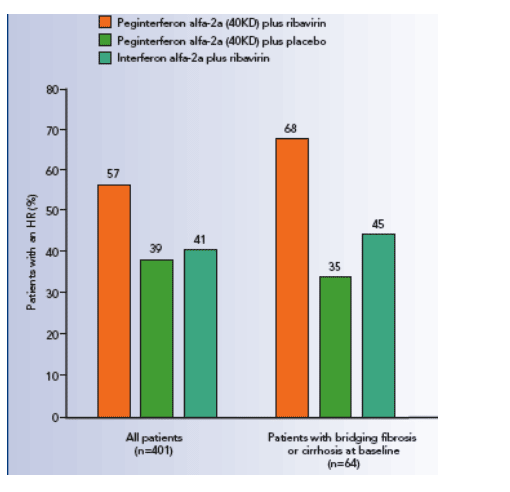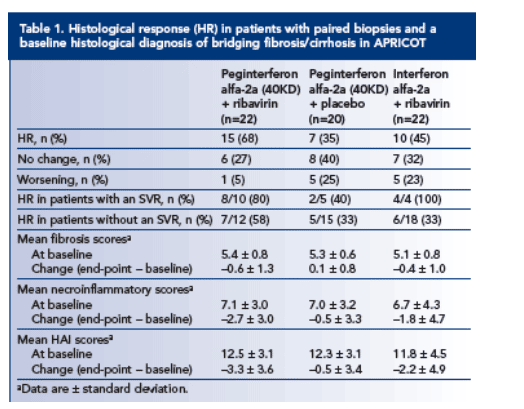 |
 |
 |
| |
Cirrhotic Non-Responders Improve Liver Condition with Pegasys/RBV in APRICOT Study
|
| |
| |
Reported by Jules Levin
3rd IAS Conference July 24-27, 2005
Rio de Janeiro
"Histological response to peginterferon alfa-2a (40KD) (PEGASYS)
plus ribavirin (COPEGUS) in HIV-HCV co-infected patients with
bridging fibrosis or cirrhosis in the AIDS PEGASYS Ribavirin
International Co-infection Trial (APRICOT)"
Patients with bridging fibrosis or cirrhosis(advanced liver disease) had improved liver condition (histology) even if they did not achieve a Sustained Viral Response (non-responders). Here are the study results reported in a poster at IAS-Rio.
E. Lissen,1 N. Clumeck,2 R. Sola,3 M. Mendes-Correa,4 J. Montaner,5 M. Nelson,6 H. Sette Jr,7 P. Buggisch,8 J. Main,9
J. DePamphilis,10 D.T. Dieterich11
1Hospital Virgen del Rocio, Sevilla, Spain; 2CHU St-Pierre, Brussels, Belgium; 3Hospital del Mar, Universitat Autónoma de Barcelona, Barcelona, Spain; 4University of Sao Paolo, Sao Paolo, Brazil;
5St Paul's Hospital, Vancouver, BC, Canada; 6Chelsea and Westminster Hospital, London, UK; 7Instituto de Infectologia, "Emilio Ribas" Ambulatorio De Hepatologia, Sao Paulo, Brazil;
8Universitat Klinik Hamburg, Medical Klinik und Poliklinik, Hamburg, Germany; 9Imperial College School of Medicine, St Mary's Hospital, London, UK; 10Roche, Nutley, NJ, USA;
11Mount Sinai School of Medicine, New York, NY, USA
Patients with HIV-HCV co-infection can have accelerated progression
of HCV-induced liver disease; thus, treatment that retards progression of liver disease would be of great benefit.
The objective of this study analysis was to determine whether the favorable histological responses obtained with peginterferon alfa-2a (40KD) plus ribavirin in
the overall APRICOT population extended to patients with a pretreatment histological diagnosis of bridging fibrosis/cirrhosis prior to treatment.
The combination of peginterferon alfa-2a (40KD) (PEGASYS) plus ribavirin (COPEGUS) produced significantly higher sustained virological response (SVR)
rates than in either peginterferon alfa-2a (40KD) monotherapy or conventional interferon plus ribavirin (40% vs 20% and 12%, respectively, p<0.001) in
HIV-HCV co-infected patients in APRICOT, a large, randomized, international phase III trial.
In addition to significantly better SVR rates, the combination of peginterferon alfa-2a (40KD) plus ribavirin also produced significantly greater histological response rates in the study population, defined as a 2-point or more reduction from baseline in the Ishak-modified histological activity index (HAI). Among patients with paired liver biopsies a histological response was achieved in 57% (77/135) of patients treated with peginterferon alfa-2a (40KD) plus ribavirin, 39% (52/134)
of those treated with peginterferon alfa-2a (40KD) plus placebo (p<0.017) and 41% (54/132) of those who received conventional interferon plus ribavirin (p=0.04).
Importantly, histological improvement was documented in patients with and without SVRs, demonstrating that histological improvement can occur in the absence of virological eradication. Patients with advanced fibrosis are in particular need of effective therapy. For this reason we examined histological response rates specifically in patients enrolled in APRICOT who had bridging fibrosis or cirrhosis at baseline (Ishak stage 4-6).
--68% (15/22) with paired biopsies & a baseline diagnosis of bridging fibrosis/cirrhosis & taking Pegasys/RBV had an improved histology (condition of the liver, also called fibrosis); 35% taking Pegasys alone, and 45% taking standard interferon + RBV had an improvement in liver histology.
--In patients with bridging fibrosis/cirrhosis, histological improvement was also documented in patients who did not achieve an SVR. Thus, histological improvement may be an alternative goal of treatment in patients who do
not achieve an early virological response at week 12.
Patients in Apricot with bridging fibrosis/cirrhosis:
For patients receiving Pegasys + Copegus in APRICOT-
--8/10 patients with an SVR had an improvement in histology,
--7/12 patients without an SVR had an improvement in histology.
Patients who received Pegasys without ribavirin or who received standard interferon + ribavirin who did not achieve an SVR also had a histologic response:
--33% (5/15) receiving Pegasys alone
--33% (6/18) receiving standard interferon + ribavirin
Figure 1. Histological response (HR) in patients with bridging fibrosis or
cirrhosis and who had paired biopsies in APRICOT.


Paired biopsies were obtained from 64 of the 134 patients who received at least one dose of study drug in the trial and had a diagnosis of bridging fibrosis or cirrhosis at baseline.
Improvement was observed primarily in the necroinflammatory components of the HAI scores. Improvements in the HAI were greater, and histological
response rates higher, in patients with bridging fibrosis/cirrhosis who received peginterferon alfa-2a (40KD) plus ribavirin than either of the other two
treatments (Table 1). Histological status deteriorated in only 1 of 22 patients in this treatment arm compared with five patients in each of the other groups.
In general, histological response rates in patients with cirrhosis/bridging fibrosis were similar to, or slightly higher, than those reported for the overall population
with paired biopsies (Figure 1).
A high proportion of patients with cirrhosis/bridging fibrosis at baseline who achieved an SVR with peginterferon alfa-2a (40KD) plus ribavirin also had a
histological response (eight of ten patients). Importantly, across all three treatment groups at least one-third of patients who did not achieve an SVR showed histological improvement (Table 1).
METHODS
Patients eligible for APRICOT were HCV treatment-naive adults (aged >18 years) with quantifiable serum HCV RNA by polymerase chain reaction (PCR) assay (>600 IU/mL; COBAS AMPLICOR HCV MONITOR Test, v2.0), elevated
aminotransferase (ALT) levels, compensated liver disease, and stable HIV disease. Patients were required to have liver disease consistent with a diagnosis of chronic hepatitis C based on a liver biopsy obtained within
<15 months prior to enrollment.
Patients were randomized to 48 weeks of treatment with peginterferon alfa-2a (40KD) 180 mg/week plus ribavirin 800 mg/day, peginterferon alfa-2a (40KD) plus placebo, or conventional interferon alfa-2a 3 million IU three times weekly plus ribavirin. The study incorporated a 24-week untreated follow-up phase.
The current analysis included all patients with a histological diagnosis of cirrhosis or bridging fibrosis who received at least one dose of study medication
and had a follow-up liver biopsy obtained >56 days after treatment.
- biopsies were scored by local pathologists using the Ishak-modified system
- the necroinflammatory grade is scored from 0 (no necroinflammation) to a maximum of 18, and the fibrosis stage is scored from 0 (no fibrosis) to 6 (probable or definite cirrhosis)
- in this analysis 'bridging fibrosis' includes all patients assigned a fibrosis stage of 5 and those who were assigned stage 4, but had >3 bridges or nodules present upon scoring. Thus, 17 patients who had these characteristics and a stage 4 fibrosis score have been included
--the necroinflammatory and fibrosis scores are added together to give a total HAI score.
Histological response was defined as a ≥2-point reduction from baseline in the total HAI score. No change was defined as a change in HAI score of +1,
-1, or 0; worsening was defined as an increase in HAI score of ≥2 points.
SVR was defined as undetectable HCV RNA by qualitative PCR (<50 IU/mL by COBAS AMPLICOR HCV Test, v2.0) at the end of the 24-week untreated
follow-up period (week 72).
|
|
| |
|
 |
 |
|
|